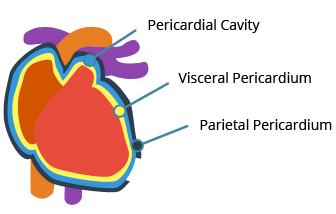Pericardial Mesothelioma
 Pleural mesothelioma and peritoneal mesothelioma account for the vast majority of all diagnoses of mesothelioma. However, pericardial mesothelioma and mesothelioma of the tunica vaginalis do occur. The majority of analyses on these diseases, however, have been carried out on individual case studies with the medical literature describing only a few hundred cases of either the pericardial or tunica vaginalis form of the disease . Because of this, developing effective treatment plans for these rare cancers has been a serious problem.
Pleural mesothelioma and peritoneal mesothelioma account for the vast majority of all diagnoses of mesothelioma. However, pericardial mesothelioma and mesothelioma of the tunica vaginalis do occur. The majority of analyses on these diseases, however, have been carried out on individual case studies with the medical literature describing only a few hundred cases of either the pericardial or tunica vaginalis form of the disease . Because of this, developing effective treatment plans for these rare cancers has been a serious problem.
Function of the Pericardium
The pericardium is a tissue sac that contains the heart and the primary blood vessels. It has two layers: the fibrous pericardium and the serous pericardium. The fibrous pericardium is the outermost layer and is made up of connective tissue that protects the heart and anchors it to the surrounding walls. It’s a dense, thick tissue layer. The inner layer, the serous pericardium, is itself made up of two layers: the parietal pericardium, which is directly connected to the fibrous pericardium, and the visceral pericardium which forms the outer surface of the heart. In between the parietal and visceral pericardium is the pericardial cavity, where pericardial fluid is secreted to ease the movement of the heart within its space. Like the pleura and the pleural cavity, if the function of the pericardium becomes compromised, the pericardial cavity can develop a build-up of the cavity’s lubricating fluid and this can impact the heart’s proper function. This build-up is known as a pericardial effusion. When one of the layers of the pericardium becomes malignant, it is known as pericardial mesothelioma.
Overview of Pericardial Mesothelioma
The literature on this disease suggests a highly aggressive cancer with an average life span of less than six months from diagnosis. With so few cases to actively study, the information regarding treatments, symptoms and prognosis is limited. In fact, many patients are unaware they have this form of cancer and the diagnosis is made only during autopsy. For patients diagnosed when still living, commonly reported symptoms include fever, dyspnea, night sweats and many present with symptoms of congestive heart failure and pericardial effusions. Surgery has been used for palliative benefit for some, but the literature suggests the disease is not very amenable to treatment.
Recent Case Study of Pericardial Mesothelioma
A case of primary pericardial mesothelioma in a forty-four year-old man has recently been covered in a medical journal. This man was treated with Alimta plus carboplatin, which is the FDA-approved standard of care for mesothelioma. He responded well to the treatment and lived for sixteen months after his initial diagnosis, exceeding the anecdotal average by nearly 10 months. The researchers suggest that using standard treatments for the rarer forms of the disease may still have beneficial effects for the patient.


